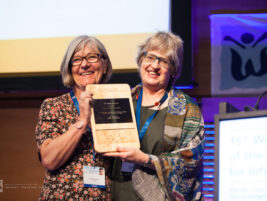I was delighted to read “Attachment Theory in Clinical Work with Children,” edited by David Oppenheim & Douglas Goldsmith (Guilford Press, 2007) while attending the WAIMH meeting this summer in Leipzig, Germany. This volume is a treat to read, providing a wonderful synthesis of research and clinical practice. While a number of books have generally addressed the clinical application of attachment, this book stands out in its emphasis on case studies and details of practical applications. What struck me as I read was how much reading this book resembled attending the meeting. Like the WAIMH meeting, this volume brings together an impressive array the leading scientists and theoreticians in the field of attachment research. Most impressive, however, is not simply the academic credentials of the contributors, but their ability to delve into the clinical applications of their work. Chapters skillfully weave together summaries of the current research, state-of-the-art clinical practice, and detailed case studies to illustrate concepts presented.
The book is divided into two main parts. In the first half, chapters emphasize the clinical application of research-based attachment assessment methods. The second half emphasizes interventions with children and their families that are rooted in attachment principles.
The first section begins with a chapter by Charley Zeanah, who sets the stage for what is to come. While the representational interview he describes, the Working Model of the Child Interview, has been described previously, this chapter weaves a description of the interview through a richly detailed, lucid case study. Excerpts from the case study narrative are provided, and Dr. Zeanah’s commentary guides the reader through his reflections on the meaning of these responses and their clinical significance. The next chapter by Nina Koren-Karie and colleagues introduces the reader to another research-based tool, the Insightfulness Assessment, which, briefly, involves having parents observe a video of their child and describe their own perceptions of what the child may have been thinking and feeling. The authors introduce the clinically-relevant concept of insightfulness and summarize the research using this method. This chapter is also richly clinically detailed, with two case studies and helpful narrative samples drawn from their intervention research. The interview is used to help derive clinical goals in these cases, and it was notable that the interview helped identify both risks (intervention targets) but also strengths. In chapter 3 Miriam Steele and colleagues parallel work on attachment in infancy, highlighting the ways that careful observation of moment-to-moment interchanges between late-adopted children and their parents can provide a window into the “attachment facilitative behaviors” that create the opportunity for child healing in this new relational context. They provide a detailed overview of their approach to observation of parent-child interaction, including a description of their coding systems, and discuss how they use they use these observations as a key component of a brief feedback intervention with parents. The clinical relevance of this work is made evident in the ways they use moment-to-moment observations to identify families most at risk, and identify the critical need to help parents learn to override avoidant signals commonly sent by late-adopted children. Mary Dozier and colleagues, in chapter 4, extend this topic by describing their work with foster parents using the “This is My Baby” interview. They have identified foster parent commitment as a key predictor of attachment outcomes for foster parent-child dyads, and in this chapter provide brief vignettes to illustrate comments that reflect high versus low commitment. Their conclusions underscore the need for both systems change and psychotherapeutic approaches to enhance foster parent commitment. Finally, in chapter 5, David Oppenheim and colleagues present the Reactions to Diagnosis Interview (RDI). Following an overview of prior work with this instrument and a theoretical rationale, authors then provide a detailed summary of their work with the RDI with parents whose children have been diagnosed on the autism spectrum. Vignettes illustrate the range of “resolution” with respect to the diagnosis, and data show that parental resolution is linked to the quality of caregiving, even in the context of raising a child on the autism spectrum. The authors underscore the need to legitimize attention to parents’ feelings in the context of diagnosis, as so often the child’s needs occupy the sole focus of attention, leaving parents without necessary support to work through their reactions and respond with sensitivity to their child’s needs.
The second half of the book begins with a chapter by Amy Bush and Alicia Lieberman, who describe an integrated approach to treating young children exposed to family violence that brings together two lines of research—trauma research, which highlights the harmful effects of traumatic stress on parents and children, and attachment research, which emphasizes the importance of the parent-child relationship as a potential moderator of the harmful effects of trauma. They recommend a “dual lens” in work with children and families impacted by domestic violence, and illustrate this dual focus in a richly detailed case study. In chapter 7 Powell and colleagues describe the Circle of Security (COS), an intervention explicitly based on attachment theory. The authors provide a case study that walks us through not only various aspects of a COS treatment, but also introduces a number of powerful and therapeutically useful metaphors derived from this framework. The reader leaves with more “tools in the toolbox” for talking with parents in clear, straightforward ways about complex attachment constructs. In the next chapter Douglas Goldsmith broadens the therapeutic lens to focus on how attachment-based interventions in the preschool context can be used in tandem with parent-child psychotherapy. The preschool setting has the opportunity to provide the child with nurturing interactions that challenge the children’s view of adults as either punitive or unavailable. Through interaction with staff children learn that adults can be called upon to help co-regulate, soothe, comfort, and support positive relational development. A case study makes clear the ways that parent psychotherapy and child-focused together work powerfully to support child healing. In the last chapter Arietta Slade takes a slightly different focus, synthesizing attachment theory and psychoanalytic process, with a focus on the mentalization of affective dysregulation and therapeutic change. She provides two case studies, one illustrating disorganization and frightening maternal behavior during the first year of life, and the second describing her treatment of an adult woman who she similarly understands as having a disorganized style with respect to attachment. The latter provides a particularly nuanced view of how attachment concepts infuse and can help clarify the nature of individual psychotherapeutic work with an adult client.
In all, this book provides a refreshing view of attachment concepts with a strong emphasis on actual clinical application. While the authors have each contributed to the strong research base for attachment theory, in this volume what is most evident is their capacity for insightful, meaningful application of this work in real-world clinical work. I highly recommend it!
Authors
Rosenblum, Kate,
United States








